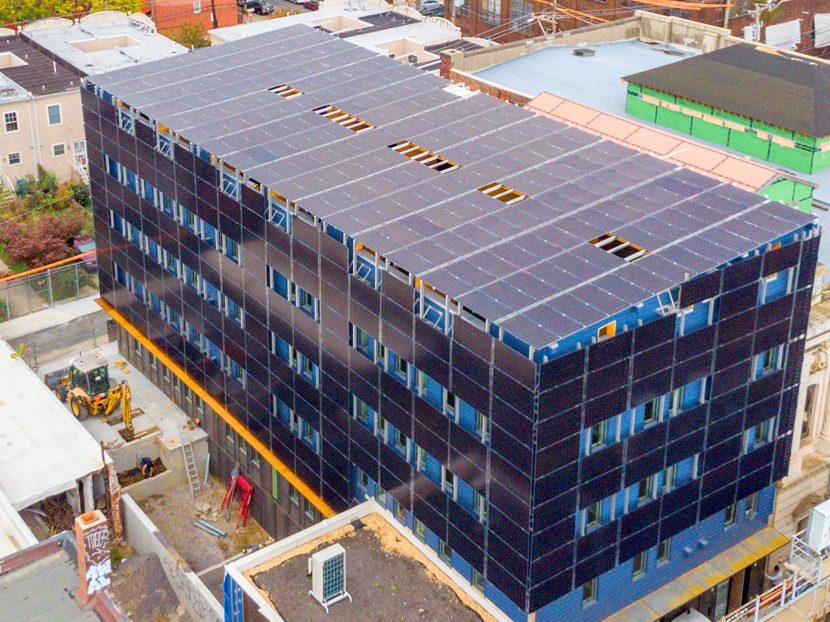Zero Energy: Why Wouldn’t You?
Clean-energy systems are less expensive at scale, project teams are more educated, and data collection is completely integrated.

I spend a lot of time visiting clean-energy projects. In early 2019, I toured down the West Coast, visiting buildings, micro-grids and electric fleet projects. Later in the year, I trekked through a handful of sites in Canada. In the first few months of 2020, I toured houses and facilities in Maine, Massachusetts, New York state, Pennsylvania, Georgia, Louisiana and Texas.
When talking to builders, plumbing engineers and architects, there are three words I’ve heard a lot lately. I know what you’re thinking, but this isn’t a romance novel. The three words are, “Why wouldn’t you?”
There was a time when it was hard to find people who were working on green buildings. It was difficult to find green projects that went smoothly from a technical point of view. It was challenging to find projects that were economically viable, or that even kept track of the data needed to assess whether they made financial sense. All this is now in the past.
Clean-energy buildings are becoming easier to build than ever before because the technology is more deliberate and more capable. Clean-energy projects are better economically because more are built each year. Clean-energy systems are less expensive at scale, project teams are more educated, and data collection is completely integrated.
Commissioning, ROI and emissions tracking have become essential parts of the construction process. And as for finding people who are working in this space — it’s getting harder to find people who are not.
Philly Sustainable Multifamily Projects
“About 15 years ago, we thought a sustainable building meant collecting rainwater, using pervious pavement and solar,” says Tim McDonald, principal and senior architect at builder/developer Onion Flats. “We didn’t know very much about building science.”
Then USGBC’s LEED rating system came along and it was more holistic, he notes: “We built some of the first LEED Platinum and Gold projects in Philadelphia. After three or four projects, we began to realize that energy was a piece of LEED, but it’s the piece requiring most of our attention. LEED also includes other things like low flow toilets that we were already doing. I mean, if you can get the same performance out of a toilet with half the water, why wouldn’t you?”
McDonald adds that buildings create about 40 percent of the greenhouse gas emissions in North America. “If we don’t address the energy use in buildings, we’re in real trouble,” he says. “So we became interested in net-zero and passive house because we understood that the building envelope is a primary part of the HVAC strategy.”
Onion Flats is now well-respected for its architectural leadership and progressive near-zero design-build projects in Philadelphia. “Every good manager in every interview says ‘It’s all about the team,’ but those are more than words in the construction business, especially with tight building envelopes,” McDonald explains. “Commitment and knowledge are critical.”
Hot Water Solutions to Reduce Building Energy
For example, McDonald notes that his plumbing guru, Gary Klein, helped the group “drastically reduce” building energy through hot water solutions.
“We don’t bring gas into our buildings; it’s relatively easy to solve for ventilation, heating and cooling, and cooking with electricity,” McDonald says. “The difficult one is hot water. And it’s important because after heating and cooling, hot water is the greatest energy consumer in a multifamily building.”
A typical multifamily building would include a centralized boiler in a basement mechanical room. As Tim and I visit Front Flats, a 28-unit residential and office building in the Kensington-Fishtown area of Philadelphia built by Onion Flats, he says that setup resulted in a significant amount of energy lost in the distribution of the hot water.
“Gary showed us how to decentralize the hot water with these off-the-shelf heat pump water heaters,” he explains. “So, there are a couple here in the mechanical room and a pair in two other locations in the building. We located them right below the plumbing in the units, directly below the bathrooms and kitchens. It meant we reduced the number of horizontal runs as much as possible. That cut the piping by 50 percent, pipe insulation by 50 percent and our heat loss by 50 percent.”
Typically, a recirculation line is added to circulate hot water through the building continuously, with the furthest fixture, in this case, nearly five stories above the heat source. Instead, Klein went one step further and introduced a pipe-in-pipe system.
“Viega makes a fitting that caps the supply and allows us to put a PVC pipe inside the supply line so when the water gets to the top of that riser, it goes directly into the recirculation,” McDonald explains. “This cuts the heat loss and insulation in half because the supply line is insulating the recirculation line. Why doesn’t everyone do this?”
Why wouldn’t you?
He and his solar guru, Ron Celentano, also took radical steps with the solar panels at Front Flats. Rather than confining them to the roof, they hung them vertically on the entire east, west and southern facades, floating a couple of feet from the walls so that they serve as window shades for summer cooling, which can be a challenge with passive house buildings.
Front Flats, which now looks like a big battery, is not a certified Passive House. But was designed to be, and came pretty close, with its blower door test at .79 rather than the .6 required. The panels also provide a filtered shade effect for the green roof on the top floor.
Financing a Passive House
McDonald doesn’t just build net-zero and passive house structures, he promotes them. He provides seminars, lectures and workshops all over North America on the tricks of modern trade.
“One of the research projects we took on about five years ago was to introduce the affordable housing industry in Pennsylvania to the passive house standard through the Low-Income Housing Tax Credit program,” he says. “We went to the Pennsylvania Housing Finance Agency (PHFA) and showed them one project we did at the same cost as other developers were doing their code-built projects. We said, why not give it a try? Why not promote a passive house to developers?”
The mechanism Onion Flats’ used is the Qualified Allocation Plan. Under the plan, the more points you have, the more likely you are to get funding. Only about one-third of the projects receive funding, so it’s competitive. “We said, why not put Passive House in for 10 extra optional points?” McDonald notes.
The first year, 85 projects applied for funding and 32 of them, or 38 percent, came in as Passive House. The PHFA funded seven of the Passive House projects, which were each 50 or 60 units. Everyone wanted to know if they could be built for the proposed budgets.
“They all came in on budget; they built them for what they said at the application phase, 100 percent,” McDonald says. “People wondered if it was a fluke. In the first year, the average cost for the Passive House projects was 2.5 percent more than equivalent code-built projects.”
The PHFA decided to continue with the Passive House projects. In the second year, they funded 10 projects, but the numbers flipped — the Passive House projects came in 2 percent or 3 percent less than the cost of the code-built projects. The third and fourth years saw the same results.
“What this says to me is that when we are forced, by the code or financing requirements, people get creative and they build within the budget,” McDonald notes. “Builders don’t share everything, but the PHFA requires some operating cost data, and I was told we hit what was projected — about 75 percent less energy with 60 percent energy cost savings or more.”
Ontario Custom Homes
Sixty percent energy savings is also the number that applies to several net-zero single-family homes in Oakville, Ontario, according to builder Fil Capuano of Chatsworth Fine Homes. In this case, we’re not talking about affordable housing. Homes in this neighborhood cost millions of dollars, and although wealthy people are not known for being frivolous with money, many are not much different than the rest of us when it comes to worrying about climate change.
“I was pleasantly surprised that once we explain to homeowners that it’s a research-based environmental third-party program, they were very happy to do something about emissions,” Capuano says. “We will complete three net-zero buildings in this community by the end of 2020.
Of course, the homeowners will get healthy and comfortable systems that save money on utilities, he adds: “There’s a 2 percent to 4 percent increase in upfront construction costs and the payback is five to seven years. The equipment life is 15 to 20 years or more, so why wouldn’t you? Why would you want to build a home that’s obsolete in a few years?”
The Ontario building code is currently stair-stepped, Capuano explains: “People see it as common sense. It’s going to be more comfortable and net-zero is the sweet spot. It’s the culmination of more than 40 years of building research.”
He takes me into the basement of a 5,800-square-foot home that has been decorated by a top-level interior designer. Every inch is beautiful. The owners sell Rolls Royce automobiles in Toronto.
“As you can tell, the temperature is just as comfortable in the basement as upstairs, but there’s no special heating in the basement and the insulation isn’t excessive,” he says. “It’s about R25 in the walls, R60 in the attic, with rigid foam under the slab. The windows are double pane with a special coating. What everyone knows as a vapor barrier is now more carefully managed as the air barrier.
“These measures have made a big impact. A house like this used to have 42,000 BTUs of heat loss; now it’s half that.”
Air-source heat pumps and heat recovery ventilators condition the whole house, and the load is more precisely managed.
“We attacked areas that are proven to be problematic, including the ductwork,” Capuano explains. “Typically, ducts lose 50 percent to 75 percent of their energy. These are only losing 5 percent.”
He says the new code says to tape the ducts. So they taped them and also sealed them using a product called Aeroseal. The formula is derived from a natural organic compound. It’s been independently verified as having extremely low VOCs.
Zero-Energy Trends
Whether we’re talking about mansions in Oakville, affordable apartments in Philadelphia, or thousands of middle-priced suburban homes in Austin (see my April 2020 column), more and more builders are asking, “Why wouldn’t I build to net-zero or passive house standards?”
A zero-energy, or net-zero-energy building, produces as much renewable energy as it consumes over a year. It typically has low energy demand and is powered by solar panels either on site or nearby.
According to the Net Zero Energy Coalition, now called Team Zero, some 22,146 net-zero units were in design, construction or operation during 2019, representing a 59 percent increase over the prior year’s inventory. There were another 31,000 residential units in the planning stages.
Grand View Research forecasts $78.8 billion growth in the global zero-energy building market by 2025. Says Team Zero: “Homebuilders and developers pursuing zero-energy projects are taking the lead in what they see as a profitable future.”
And really, why wouldn’t you?





